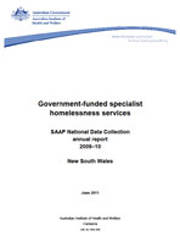Summary
This publication is one of eight state and territory supplements that accompany the 2009–10 national annual report on the use of government-funded specialist homelessness services (AIHW 2011a). Information to aid readers in interpreting the data is presented in the national report and appendixes (AIHW 2011i).
In line with the national picture, in New South Wales:
- the majority of clients were female
- the average age of clients was in their early thirties
- Aboriginal and Torres Strait Islander people were over-represented relative to their population size
- clients commonly sought support because of interpersonal relationship, accommodation, or financial related issues
- immediately following support, most clients were living in a house or flat, they were not employed, and their main source of income was a government pension or benefit.
Some other points of interest in New South Wales were:
- the rate of use of specialist homelessness services was lower than the national average
- clients were supported and accommodated for relatively long periods, with the lengths of support and accommodation being longer than the national average
- seeking support primarily because of problematic drug, alcohol and substance use was more commonly reported than in other jurisdictions
- there were relatively high levels of people exiting support to either sleep rough or to live in an institutional setting compared with other jurisdictions.



